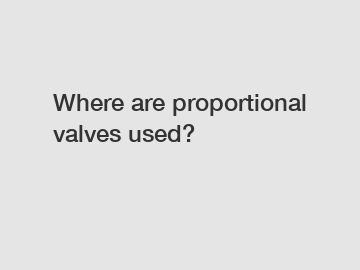Where are proportional valves used?
Where are proportional valves used?
Proportional valves, also known as proportional control valves, are widely used in various industries and applications for their ability to provide precise control of flow, pressure, and direction of hydraulic or pneumatic fluids. These specialized valves are used in a range of systems, from industrial machinery to automotive applications. Let's explore some of the key areas where proportional valves find extensive usage.
1. Industrial Automation:

Proportional valves play a crucial role in industrial automation, where precise control of fluid flow is required. They are frequently employed in applications such as injection molding machines, metal forming machinery, and assembly lines. By adjusting the valve opening, the amount of fluid passing through can be precisely controlled, allowing for accurate positioning and movement control.
2. Hydraulic Systems:
In hydraulic systems, proportional valves are used to regulate fluid flow, pressure, and direction. They are commonly found in construction machinery, such as excavators and cranes, where precise control of hydraulic functions is essential. Proportional valves enable operators to control the speed and force of hydraulic actuators with high accuracy, improving productivity and safety.
3. Pneumatics:
Proportional valves are also extensively used in pneumatic systems, where compressed air is the driving force. These valves regulate the airflow to actuators, enabling precise control of pneumatic cylinders and valves. Pneumatic proportional valves are often employed in applications such as robotics, material handling, and pick-and-place machines, where rapid and accurate movements are required.
4. Mobile Equipment:
Proportional valves have found their way into various mobile equipment, including agricultural machinery, mining equipment, and forestry machinery. These valves enable operators to precisely control hydraulic functions, such as steering, lifting, and loading operations. By incorporating proportional valves, the efficiency, flexibility, and safety of mobile equipment are greatly enhanced.
5. Automotive Industry:
In the automotive industry, proportional valves are used in various applications, such as braking systems and suspension control. In anti-lock braking systems (ABS), proportional valves help regulate the hydraulic pressure applied to individual wheels, enhancing braking performance and stability. Similarly, in active suspension systems, these valves adjust the fluid flow to provide a comfortable ride while maintaining optimal handling.
6. Medical Equipment:
Proportional valves are vital components in medical equipment, where precise control of fluid flow and pressure is critical. They are commonly used in devices such as anesthesia machines, ventilators, and diagnostic equipment. Proportional valves allow medical professionals to accurately regulate gas flow rates, pressures, and mixtures, ensuring patient safety and comfort.
7. Energy and Process Industries:
Proportional valves find applications in the energy and process industries, including oil and gas, power generation, and chemical manufacturing. They are used in control systems for regulating fluid flow, pressure, and temperature. Proportional valves can significantly contribute to process efficiency, precise control, and safety in these industries.
In conclusion, proportional valves are widely utilized in various industries and applications that require accurate control of fluid flow, pressure, and direction. From industrial automation to automotive systems, hydraulic machinery to medical equipment, these valves enhance performance, efficiency, and safety. Understanding their versatile applications allows engineers and technicians to leverage the benefits of proportional valves in their respective fields.
Want more information on Applications of directional solenoid valve, Direct Acting Overflow Valve, Advantages of using proportional valves? Feel free to contact us.

Comments
0